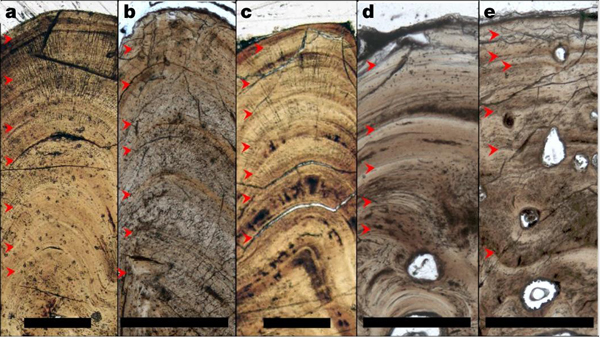An international team of researchers led by scientists from the Vrije Universiteit of Amsterdam, the Royal Belgian Institute of Natural Sciences (Brussels), Uppsala University (Uppsala, Sweden) in collaboration with colleagues from the European Synchrotron Radiation Facility, (Grenoble, France), have published a scientific paper that concludes the Chicxulub impact event took place in the northern hemisphere spring.
Writing in the academic journal “Nature”, the researchers postulate that the timing of this devastating event could have had a bearing on the types of animals that survived the mass extinction. For example, animals in the Northern Hemisphere spring (boreal spring), could have been rearing young that would have been extremely vulnerable to the dramatic, planet-wide changes. However, in the Southern Hemisphere winter was approaching (austral autumn), many mammals could have been in hibernation or sheltering in a bid to avoid the worst of the approaching wintry weather.
The Culimination of the Mesozoic
The research team postulates that the timing of the Chicxulub impact in boreal spring and austral autumn was a major influence on selective biotic survival across the Cretaceous–Palaeogene boundary.
The Remarkable Tanis Site
The Tanis Konservat-Lagerstätte preserves the devastation to a river system flowing into the Pierre Seaway (remnants of the Western Interior Seaway). The Tanis site would have been around 2,000 miles away from the impact in the Gulf of Mexico, earthquakes led to an immense water surge (a seiche), that shattered the ecosystem.
Palaeontologists have estimated that this event took place within an hour of the bolide impact. Enormous volumes of sediment engulfed fishes, ammonites and other creatures and buried them alive while impact spherules rained down from the sky.
Picture credit: Joschua Knüppe
To read an Everything Dinosaur article from last year (2021), summarising research that came to broadly similar conclusions as this study: Spring/Summer End to the Reign of the Dinosaurs.
Analysing Fish Fossils
Histological analysis of thin sections of material extracted from six fish fossils found at the site enabled the researchers to conclude that the Tanis Konservat-Lagerstätte was formed in the Northern Hemisphere spring. The fish would have grown rapidly in the spring and summer when food was abundant, but much more slowly during the autumn and winter months when food was scarce.
Lines of arrested growth (LAG) preserved in the fossils show that all the fish (paddlefish and sturgeons) died shortly after beginning a new period of rapid growth. This evidence indicates these fish died in the spring and therefore if the Tanis site is a record of the immediate aftermath of the Chicxulub impact – the bolide must have hit Earth in the boreal spring.

Osteohistological thin sections of five fish fossils from the Tanis site. The red arrows indicate LAGs and indicate that these fish died in the spring. Scale bar in images a-e = 0.5 mm. Picture credit: During et al.
Picture credit: During et al
The Last Day of the Mesozoic
BBC Studios Productions have created a special documentary entitled “Dinosaurs: The Final Day” narrated by Sir David Attenborough. The one-off programme, will piece together the events that marked the end of the Mesozoic Era, using evidence from the remarkable Tanis site.
Sir David Attenborough stated:
“Dinosaurs were among nature’s most extraordinary creatures, dominating the planet for over 150 million years before they became extinct. Tanis could be a place where the remains can give us an unprecedented window into the lives of the very last dinosaurs, and a minute-by-minute picture of what happened when the asteroid hit.”
The television programme is likely to be broadcast in the spring.
The scientific paper: “The Mesozoic terminated in boreal spring” by Melanie A. D. During, Jan Smit, Dennis F. A. E. Voeten, Camille Berruyer, Paul Tafforeau, Sophie Sanchez, Koen H. W. Stein, Suzan J. A. Verdegaal-Warmerdam and Jeroen H. J. L. van der Lubbe published in the journal Nature.
Visit the Everything Dinosaur website: Everything Dinosaur.







Leave A Comment